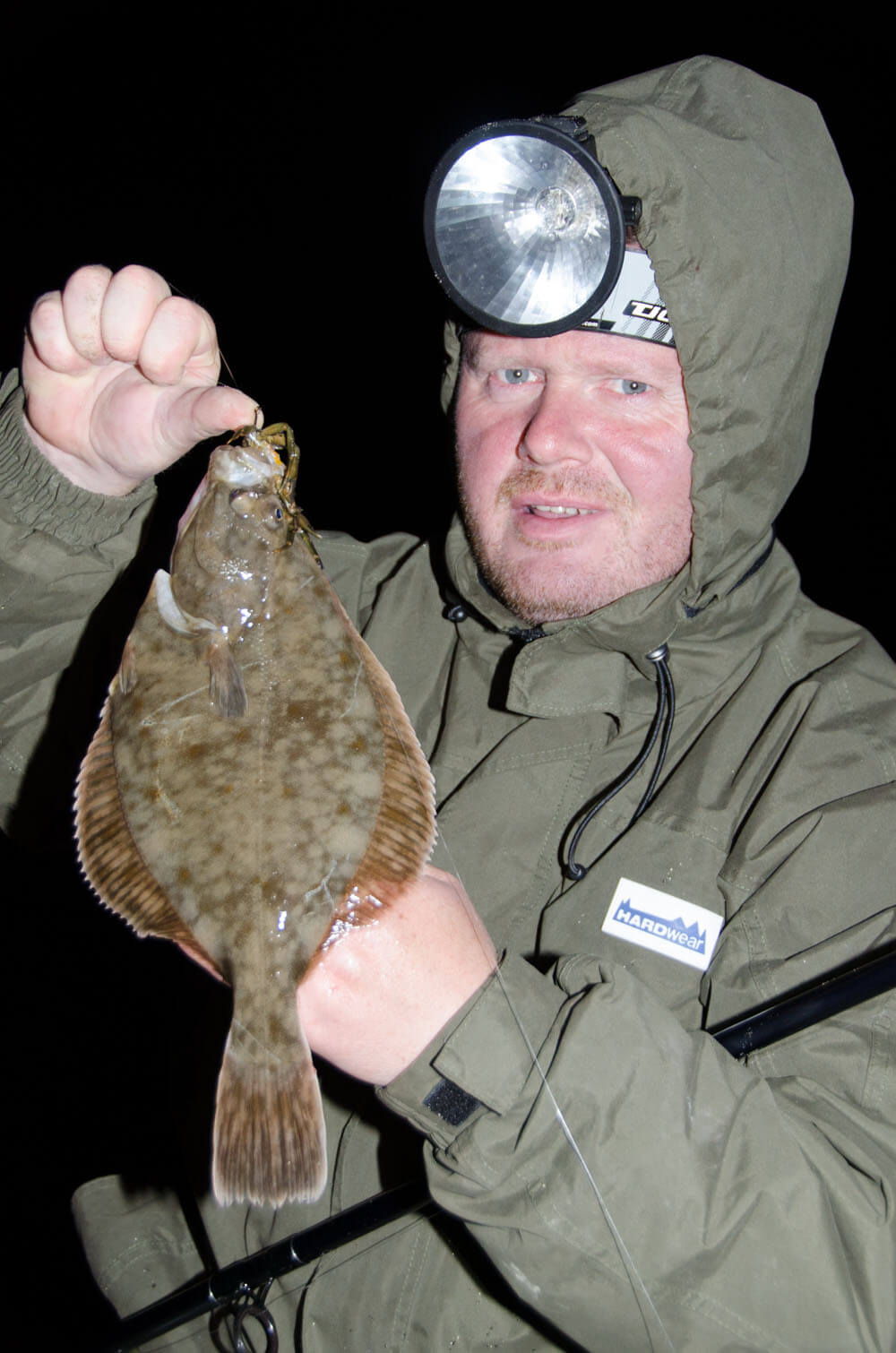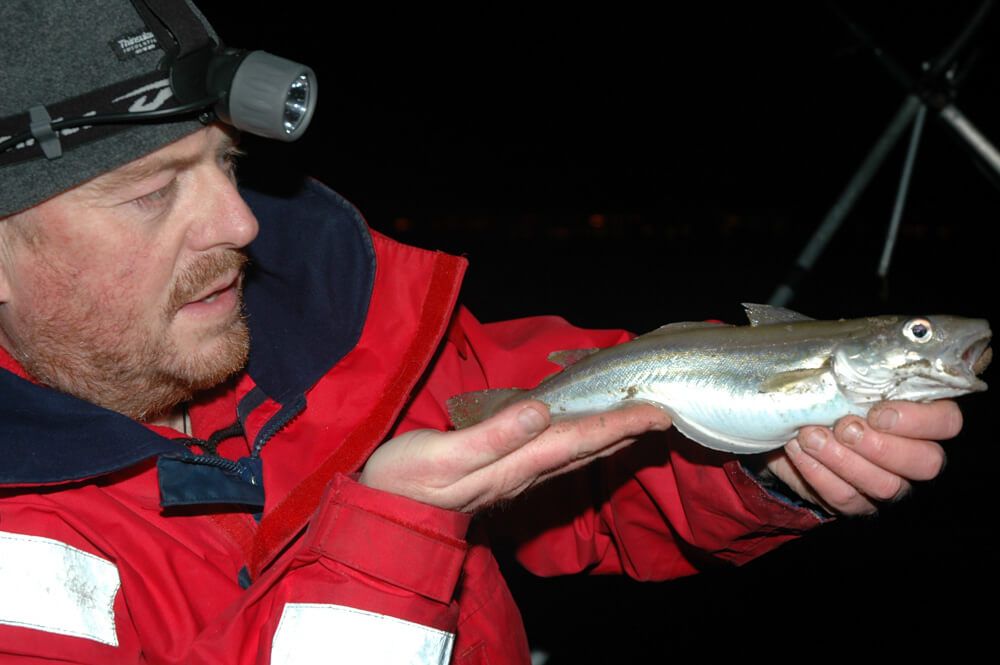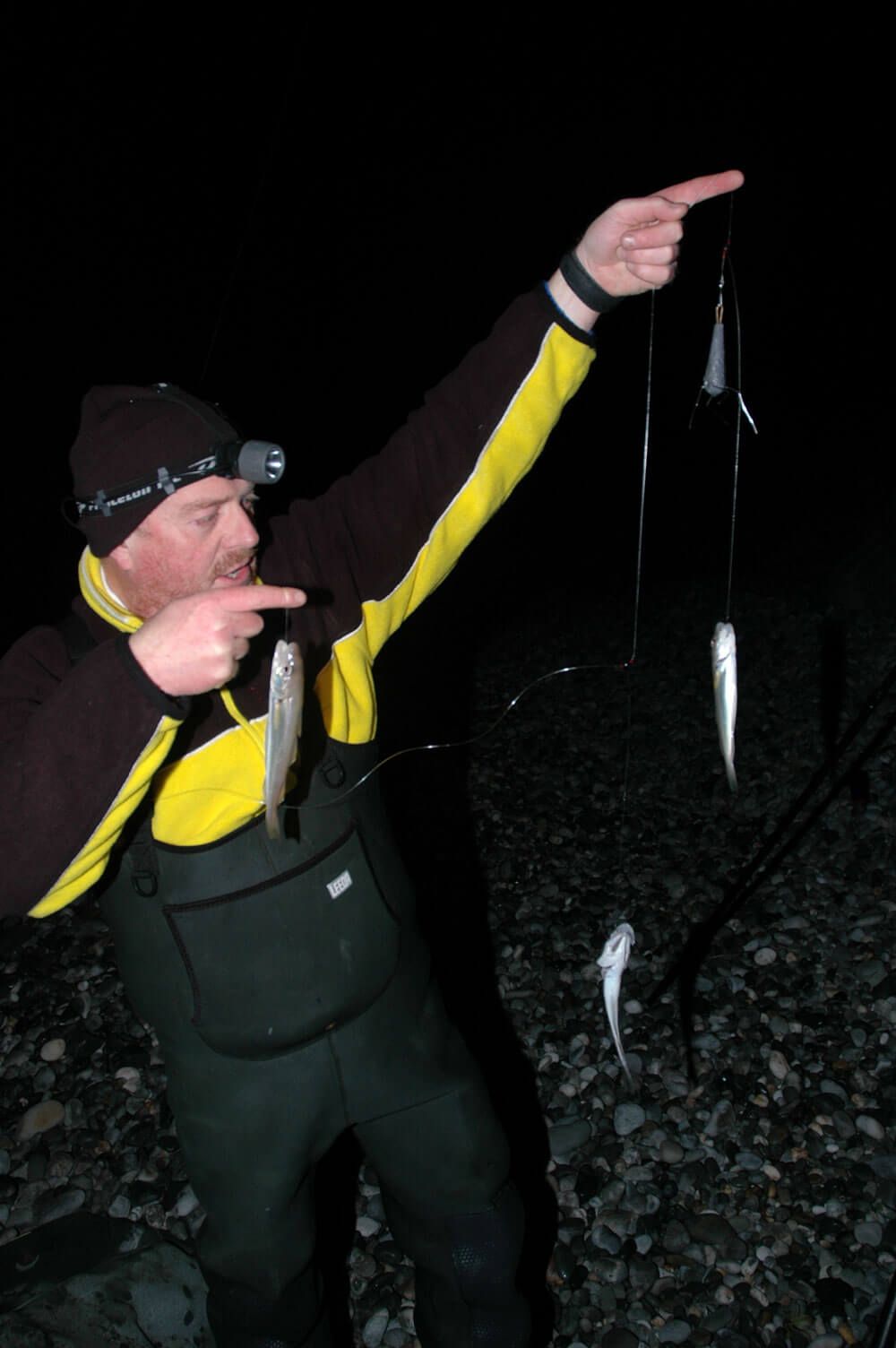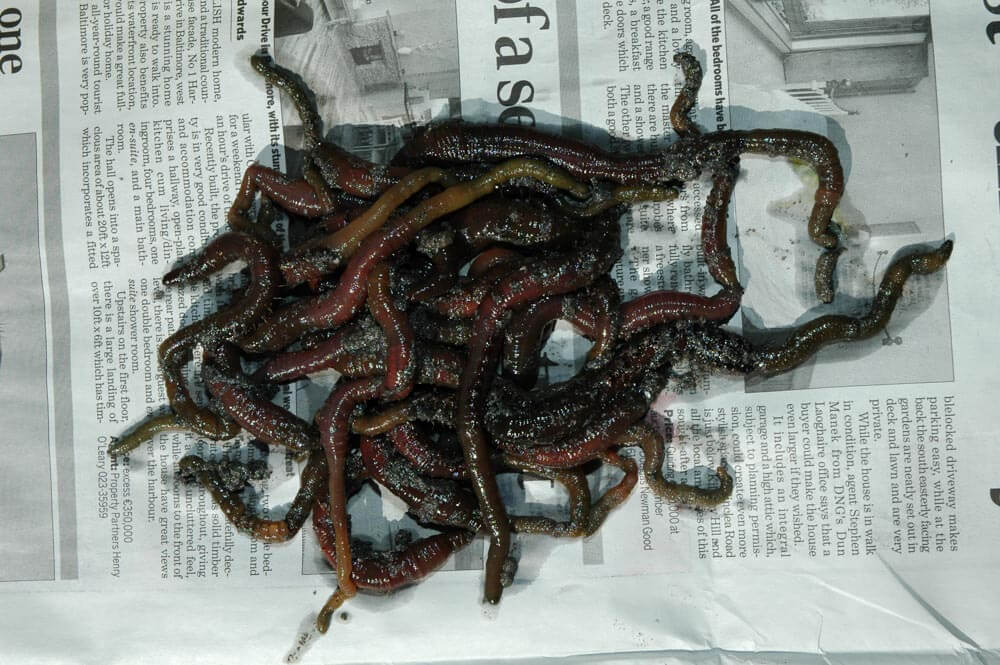February heralds the start of the most difficult period for shore anglers. The sea temperature drops to its minimum making fish semi comatose and often disinterested in food. Also it marks the time when the winter species are leaving and the summer species are still not quite ready to start migrating inwards, plus any fish that are normally found locally inshore for most of the year will be far offshore spawning. In short, you're not exactly playing to a packed audience. February and March then, are the "scratching" months when bites are at a premium and you need to try anything and everything just to make a catch.
But is it really that bad? No! Sure you need to lower your expectations a little, but there are still fish out there to be caught. Here's how I go about working through the scratch period.
SAND BEACHES
The shallow surf beaches hold flounders, dabs, dogfish, school bass, rockling and coalies. All these species, bar the dogfish, will be found very tight in near the waterline when the tide is flooding in. Tight in amongst the rolling surf tables where the water is more turbulent is where buried food gets washed out of the sand and encourages fish in to feed.

I like to time the bulk of my fishing to night time low water sessions taking in the last hour of the outward ebb tide and the first two hours of the new flood tide. This is where the bulk of food on a surf beach is situated, either immediately on or just below the mean low water line. Any fish in the near vicinity will be maximising their energy at this time to find food. It also concentrates the fish in to a defined area making them easier to catch.
You need to be casting only 30 to 50-metres to find the fish. Flounders and coalfish in particular are often just 20-metres out and working in only 60cms of water. They will work their way in to any deeper parallel gullies and travel downtide through these. The gutters hold washed in food as the first flush of tide passes over them and can provide rich pickings. Keep casting in to these until the depth of water between the gully and your self increases enough to allow fish to come closer.
As the tide floods across the flats during the middle three to four hours and up to high water, the sands hold much less natural food and fish have to actively search further afield. Bites will fall away as the fish become more scattered.
Some fish will make their way in to the high water mark, but food is very minimal here and the fishing can be erratic. The most likely catch are the more active swimmers like small bass, coalfish and dogfish who are more willing to continue searching.
The best rig is a simple three-hook paternoster made from 50lb line and 120cms long. Use short 23cm 20lb hook lengths positioned between crimp trapped beads at the top, middle and bottom of the trace. The short hook lengths are far enough apart so as not to tangle in the surf. In very calm seas, drop the hook length down to 15lb or even 10lbs breaking strain if bites are very slow. It can make a difference and improve the catch by allowing a small light bait to move more naturally in the tide.
Hooks also need to be small. Carry sizes 2, 4 and 6 Aberdeen's. The size 2 is a good all rounder, but if bites are few drop down to a smaller bait on a size 4 or 6 to improve your bite ratio.
Another tip is to use a light plain lead and let it roll around in the surf. It naturally finds all the deeper holes and gutters than will be harbouring fish and again improves your chances of a catch.
If there has been a period of heavy rain, then avoid particular sections of beach that have a stream or river flowing across them. The rain entering the sea will be colder than the sea itself and force fish away from it, plus they find the acidity intolerable and disappear elsewhere to feed.
If you have to fish near rivers then always fish on the uptide side of the freshwater outlet where the water in front of you is pure seawater. This is good advice when you're fishing near estuaries too. Fish a flanking beach on the uptide side of the estuary mouth if floodwater is evident.

STEEP-TO BEACHES
These have much deeper water and are more predictable. The fish are there most of the time, but not necessarily feeding. These beaches tend to have much more in the way of passing tidal currents and these have an effect on the times the fish feed just as much as low and high water will. I'd still choose to fish over low water, as once the new flood starts this can be the trigger to switch fish on to feed.
For continued feeding, much depends on how fast that passing tide is. If the tide is running strong, expect fish to be fairly close in. These steep-to beaches tend to be backed by shingle that disappears below the low water line. Fish will push and work along the edge of the shingle and sand junction. This is where much of any in-borne food ends up. Bites may still be slow though. If the tide starts to ease, and this can be for just a short time and influenced by shore topography and other sea currents miles away, then fish will suddenly come on the feed en-masse. As the tide returns, then bites fall away again. These periods of slacker water are often short lived.
The species available on these deeper venues will also change a little. The dabs are still evident and will often produce the bulk of the catch. Also joining them will be pout, poor cod, dogfish and even a few late codling and whiting.
The codling tend to be passing fish, but may follow a defined route. Try to locate any hidden underwater feature like a deeper hole or a small area of mixed ground. This again draws in water borne food and concentrates it, but also gives some respite for fish from the passing tide. This will be enough to interest them and hold them for a short period giving them enough time to locate your bait.
You can still do well with the three-hook rig for casting close for the dabs and pout. Stick to the size 2 Aberdeen hooks and only drop to size 4 or 6's if bites are slow and you need to fish smaller baits.
If you work at longer range, then switch to either a two hook rig with bait clips or a two-hook wishbone rig and bait clip for maximum range and the chance of codling. I prefer the V shaped wishbone as the two baits sit close together and give lots of scent to pull the fish in. I still stick to size 2 Aberdeen hooks on these rigs even though codling have much bigger mouths.
With only a slim chance of codling, I prefer to retain the smaller hooks to give me a chance of connecting with the smaller fish that take an interest in the baits. That's why I like the wishbone rig. A codling has a mouth easily big enough to swallow both hooks should one happen along, so you've a decent chance of setting one of the hooks anyway.

BAITS
This is critical. Having a good selection of different baits is often the key to making a catch at this time. You'll find that the each species will have a preference, and this preference can change on each venue almost day-by-day.
The key bait is lugworm. Black lug is useful, but due to its size needs cutting in to small sections and you lose the bulk of body juices in the process. I prefer small and juicy blow lug which you can use whole to maximise smell in the water and enable the fish to find the bait. You can do a lot with the reliable lug. Fished as individual bait it will take dabs, flounders, dogfish, codling, rockling and school bass, but not always.
King ragworm is okay, but doesn't fish anywhere near as well as the lug will.
At this time of year fish can become very choosy in what they eat often ignoring their more traditional choices. This is where combination baits come in.
A combination bait is exactly what is sounds like, two different baits fished on the same hook. A combination of lugworm tipped with a small sliver of mackerel or sprat is killer bait for dabs. You can also tip off with mussel, herring and crab to target dabs.
Flounders like razorfish, either as a tippet on lug or as the main bait. Pouting will often eat a lug tipped off with a small section of white rag and ignore the lug on its own. Also try tipping off with cockle for flatfish and codling, tip lug off with frozen crab or mussel for coalfish, and if whiting are about tip of f a worm bait with a strip of sandeel. A good flounder combo is a bunch of harbour rag tipped with mackerel when fishing around the mouths of estuaries.
If all the combinations just mentioned don't produce, don't give up. Start making up alternative combinations using the baits you have. I've had regular success with mussel and crab together for coalfish, mackerel tipped with sandeel for dabs, and rag tipped with cockle which seems to take the rockling with some consistency.
Fishing the three-hook rig means you can try three different combinations on the one rig, but swap the baits around and note what happens. If a particular combo catches a fish two or three times in a row, try baiting all three hooks with the same combo and try for three fish at once.
Also try swapping the successful combo baits from top hook to bottom hook and vice versa. Not all fish swim hard on the seabed and even dabs will swim up off the bottom to take a bait if the angle of the line is so steep that the top bait is off the seabed.
There is one other advantage to a combination bait. Once you've discovered what tippet each species prefers on the day, if a fish is too small or shy to take a whole bait into their mouths in one go, by adding the tippet bait at the hook point, you can effectively force them to bite on the point itself. This dramatically increases your chances of a hook up. This is especially effective when bites are hard to notice and fish are just nibbling at the bait.

TIPS
As stated, I prefer night fishing, but if you need to fish a daylight tide, try adding silver sequins or brightly coloured beads to the your hook traces just above the hook. In clear water this can attract dabs and flounders.
A rig made with two or three stand-off booms that hold the baits out from the rig body can often outfish a plain rig. It simply changes the way in which the bait behaves in the water and is enough to make a difference.
Don't keep your baits static on the seabed. Move them occasionally. This creates noise which can attract fish and also adds movement.
If you're fishing very close in, as you remove old bait from hooks, throw it in to the sea around you. This acts like groundbait and can draw fish closer to you and into your immediate fishing area.
If bites are slow, try casting further out or closer in. This effectively searches the water and will locate the fish as they travel with the tide.
But is it really that bad? No! Sure you need to lower your expectations a little, but there are still fish out there to be caught. Here's how I go about working through the scratch period.
SAND BEACHES
The shallow surf beaches hold flounders, dabs, dogfish, school bass, rockling and coalies. All these species, bar the dogfish, will be found very tight in near the waterline when the tide is flooding in. Tight in amongst the rolling surf tables where the water is more turbulent is where buried food gets washed out of the sand and encourages fish in to feed.

I like to time the bulk of my fishing to night time low water sessions taking in the last hour of the outward ebb tide and the first two hours of the new flood tide. This is where the bulk of food on a surf beach is situated, either immediately on or just below the mean low water line. Any fish in the near vicinity will be maximising their energy at this time to find food. It also concentrates the fish in to a defined area making them easier to catch.
You need to be casting only 30 to 50-metres to find the fish. Flounders and coalfish in particular are often just 20-metres out and working in only 60cms of water. They will work their way in to any deeper parallel gullies and travel downtide through these. The gutters hold washed in food as the first flush of tide passes over them and can provide rich pickings. Keep casting in to these until the depth of water between the gully and your self increases enough to allow fish to come closer.
As the tide floods across the flats during the middle three to four hours and up to high water, the sands hold much less natural food and fish have to actively search further afield. Bites will fall away as the fish become more scattered.
Some fish will make their way in to the high water mark, but food is very minimal here and the fishing can be erratic. The most likely catch are the more active swimmers like small bass, coalfish and dogfish who are more willing to continue searching.
The best rig is a simple three-hook paternoster made from 50lb line and 120cms long. Use short 23cm 20lb hook lengths positioned between crimp trapped beads at the top, middle and bottom of the trace. The short hook lengths are far enough apart so as not to tangle in the surf. In very calm seas, drop the hook length down to 15lb or even 10lbs breaking strain if bites are very slow. It can make a difference and improve the catch by allowing a small light bait to move more naturally in the tide.
Hooks also need to be small. Carry sizes 2, 4 and 6 Aberdeen's. The size 2 is a good all rounder, but if bites are few drop down to a smaller bait on a size 4 or 6 to improve your bite ratio.
Another tip is to use a light plain lead and let it roll around in the surf. It naturally finds all the deeper holes and gutters than will be harbouring fish and again improves your chances of a catch.
If there has been a period of heavy rain, then avoid particular sections of beach that have a stream or river flowing across them. The rain entering the sea will be colder than the sea itself and force fish away from it, plus they find the acidity intolerable and disappear elsewhere to feed.
If you have to fish near rivers then always fish on the uptide side of the freshwater outlet where the water in front of you is pure seawater. This is good advice when you're fishing near estuaries too. Fish a flanking beach on the uptide side of the estuary mouth if floodwater is evident.

STEEP-TO BEACHES
These have much deeper water and are more predictable. The fish are there most of the time, but not necessarily feeding. These beaches tend to have much more in the way of passing tidal currents and these have an effect on the times the fish feed just as much as low and high water will. I'd still choose to fish over low water, as once the new flood starts this can be the trigger to switch fish on to feed.
For continued feeding, much depends on how fast that passing tide is. If the tide is running strong, expect fish to be fairly close in. These steep-to beaches tend to be backed by shingle that disappears below the low water line. Fish will push and work along the edge of the shingle and sand junction. This is where much of any in-borne food ends up. Bites may still be slow though. If the tide starts to ease, and this can be for just a short time and influenced by shore topography and other sea currents miles away, then fish will suddenly come on the feed en-masse. As the tide returns, then bites fall away again. These periods of slacker water are often short lived.
The species available on these deeper venues will also change a little. The dabs are still evident and will often produce the bulk of the catch. Also joining them will be pout, poor cod, dogfish and even a few late codling and whiting.
The codling tend to be passing fish, but may follow a defined route. Try to locate any hidden underwater feature like a deeper hole or a small area of mixed ground. This again draws in water borne food and concentrates it, but also gives some respite for fish from the passing tide. This will be enough to interest them and hold them for a short period giving them enough time to locate your bait.
You can still do well with the three-hook rig for casting close for the dabs and pout. Stick to the size 2 Aberdeen hooks and only drop to size 4 or 6's if bites are slow and you need to fish smaller baits.
If you work at longer range, then switch to either a two hook rig with bait clips or a two-hook wishbone rig and bait clip for maximum range and the chance of codling. I prefer the V shaped wishbone as the two baits sit close together and give lots of scent to pull the fish in. I still stick to size 2 Aberdeen hooks on these rigs even though codling have much bigger mouths.
With only a slim chance of codling, I prefer to retain the smaller hooks to give me a chance of connecting with the smaller fish that take an interest in the baits. That's why I like the wishbone rig. A codling has a mouth easily big enough to swallow both hooks should one happen along, so you've a decent chance of setting one of the hooks anyway.

BAITS
This is critical. Having a good selection of different baits is often the key to making a catch at this time. You'll find that the each species will have a preference, and this preference can change on each venue almost day-by-day.
The key bait is lugworm. Black lug is useful, but due to its size needs cutting in to small sections and you lose the bulk of body juices in the process. I prefer small and juicy blow lug which you can use whole to maximise smell in the water and enable the fish to find the bait. You can do a lot with the reliable lug. Fished as individual bait it will take dabs, flounders, dogfish, codling, rockling and school bass, but not always.
King ragworm is okay, but doesn't fish anywhere near as well as the lug will.
At this time of year fish can become very choosy in what they eat often ignoring their more traditional choices. This is where combination baits come in.
A combination bait is exactly what is sounds like, two different baits fished on the same hook. A combination of lugworm tipped with a small sliver of mackerel or sprat is killer bait for dabs. You can also tip off with mussel, herring and crab to target dabs.
Flounders like razorfish, either as a tippet on lug or as the main bait. Pouting will often eat a lug tipped off with a small section of white rag and ignore the lug on its own. Also try tipping off with cockle for flatfish and codling, tip lug off with frozen crab or mussel for coalfish, and if whiting are about tip of f a worm bait with a strip of sandeel. A good flounder combo is a bunch of harbour rag tipped with mackerel when fishing around the mouths of estuaries.
If all the combinations just mentioned don't produce, don't give up. Start making up alternative combinations using the baits you have. I've had regular success with mussel and crab together for coalfish, mackerel tipped with sandeel for dabs, and rag tipped with cockle which seems to take the rockling with some consistency.
Fishing the three-hook rig means you can try three different combinations on the one rig, but swap the baits around and note what happens. If a particular combo catches a fish two or three times in a row, try baiting all three hooks with the same combo and try for three fish at once.
Also try swapping the successful combo baits from top hook to bottom hook and vice versa. Not all fish swim hard on the seabed and even dabs will swim up off the bottom to take a bait if the angle of the line is so steep that the top bait is off the seabed.
There is one other advantage to a combination bait. Once you've discovered what tippet each species prefers on the day, if a fish is too small or shy to take a whole bait into their mouths in one go, by adding the tippet bait at the hook point, you can effectively force them to bite on the point itself. This dramatically increases your chances of a hook up. This is especially effective when bites are hard to notice and fish are just nibbling at the bait.

TIPS
As stated, I prefer night fishing, but if you need to fish a daylight tide, try adding silver sequins or brightly coloured beads to the your hook traces just above the hook. In clear water this can attract dabs and flounders.
A rig made with two or three stand-off booms that hold the baits out from the rig body can often outfish a plain rig. It simply changes the way in which the bait behaves in the water and is enough to make a difference.
Don't keep your baits static on the seabed. Move them occasionally. This creates noise which can attract fish and also adds movement.
If you're fishing very close in, as you remove old bait from hooks, throw it in to the sea around you. This acts like groundbait and can draw fish closer to you and into your immediate fishing area.
If bites are slow, try casting further out or closer in. This effectively searches the water and will locate the fish as they travel with the tide.

